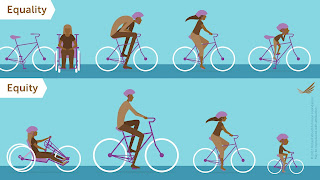Implicit Bias
Often times, we as people think we are acting with good intentions and believe ourselves to be fair in our roots. However, as good-intentioned as we think we are, the brain is tricky in that often times it has automatic responses we are not even aware of. The brain is always picking up on the surroundings and being influenced by the people and situations around us. This is where implicit bias comes in. Implicit bias is acting or thinking in a way that is rooted in stereotypes without being aware of doing so. It is a dangerous type of bias as it means that it will not change unless someone realizes they are being implicitly bias. This is why it is important to learn about implicit bias, because a better understanding of implicit bias leads to identifying ways we are being implicitly bias. OT's as healthcare providers need to be aware of implicit bias as many of our clients fall into to all different races, ethnicities, genders, socioeconomic statuses, disabilities and more. If in our treatment we act on implicit bias we are contributing to health disparities and inequalities. A presentation by the National Institute for Children's Health Quality (NICHQ) revealed that there are mortality rate disparities in children who are African America, Asian/Pacific Islanders, Latino, and Alaska Natives/American Indians. This means for those healthcare providers working in pediatrics, improving upon our implicit biases could benefit the overall population health in children. This extends beyond just pediatrics as there are health disparities across all ages. As OT's we are advocates for the populations we work with and so it is important to make sure that we ourselves take the first step to advocate for them by making sure our intentions truly match our actions.
Luckily, inequality is changeable and there are measures we can take to try and work on our implicit bias. There are few things we can do to address our implicit biases. One way, the first step I have taken, is to participate in Project Implicit. This test will give you an IAT score which will reveal to you if you have automatic, moderate, minimal, or neutral bias. Just identifying to yourself your implicit bias is a good first step. Another way is to be empathetic. This means trying to understand things we may not relate to. This can be reading books or listening to podcasts about instances people who are different than you have experienced bias. Another way is to engage in dialogue about bias. This means actually sitting down and having a conversation with someone and listening to their experiences with bias. A very interactive tool for combatting implicit bias is The Seven Day Bias Cleanse I found posted by The Seniors Flourish Podcast's episode on "OT Diversity, Inclusivity, and Implicit Bias."
The NICHQ also presented this graphic in their presentation and it really stuck out to me. I think this picture is a good visual representation in the difference between equality and equity. While equality is all about being equal, which sounds good in essence, we want to focus on equity. Equity is fair and impartial. We want our healthcare systems in be equitable in that instead of giving everyone the same treatment we are giving treatment that suits the individual as best as possible to give them the best chance. Well, that sounds about as OT as it gets. All people are different and have difference desires. You can give everyone a bike to be equal, but is using the bike that people truly want, not just possession. If we give everyone a bike that suits their needs, then we have given everyone a fair chance. This is what we must do in our treatments.
Luckily, inequality is changeable and there are measures we can take to try and work on our implicit bias. There are few things we can do to address our implicit biases. One way, the first step I have taken, is to participate in Project Implicit. This test will give you an IAT score which will reveal to you if you have automatic, moderate, minimal, or neutral bias. Just identifying to yourself your implicit bias is a good first step. Another way is to be empathetic. This means trying to understand things we may not relate to. This can be reading books or listening to podcasts about instances people who are different than you have experienced bias. Another way is to engage in dialogue about bias. This means actually sitting down and having a conversation with someone and listening to their experiences with bias. A very interactive tool for combatting implicit bias is The Seven Day Bias Cleanse I found posted by The Seniors Flourish Podcast's episode on "OT Diversity, Inclusivity, and Implicit Bias."
The NICHQ also presented this graphic in their presentation and it really stuck out to me. I think this picture is a good visual representation in the difference between equality and equity. While equality is all about being equal, which sounds good in essence, we want to focus on equity. Equity is fair and impartial. We want our healthcare systems in be equitable in that instead of giving everyone the same treatment we are giving treatment that suits the individual as best as possible to give them the best chance. Well, that sounds about as OT as it gets. All people are different and have difference desires. You can give everyone a bike to be equal, but is using the bike that people truly want, not just possession. If we give everyone a bike that suits their needs, then we have given everyone a fair chance. This is what we must do in our treatments.



Comments
Post a Comment